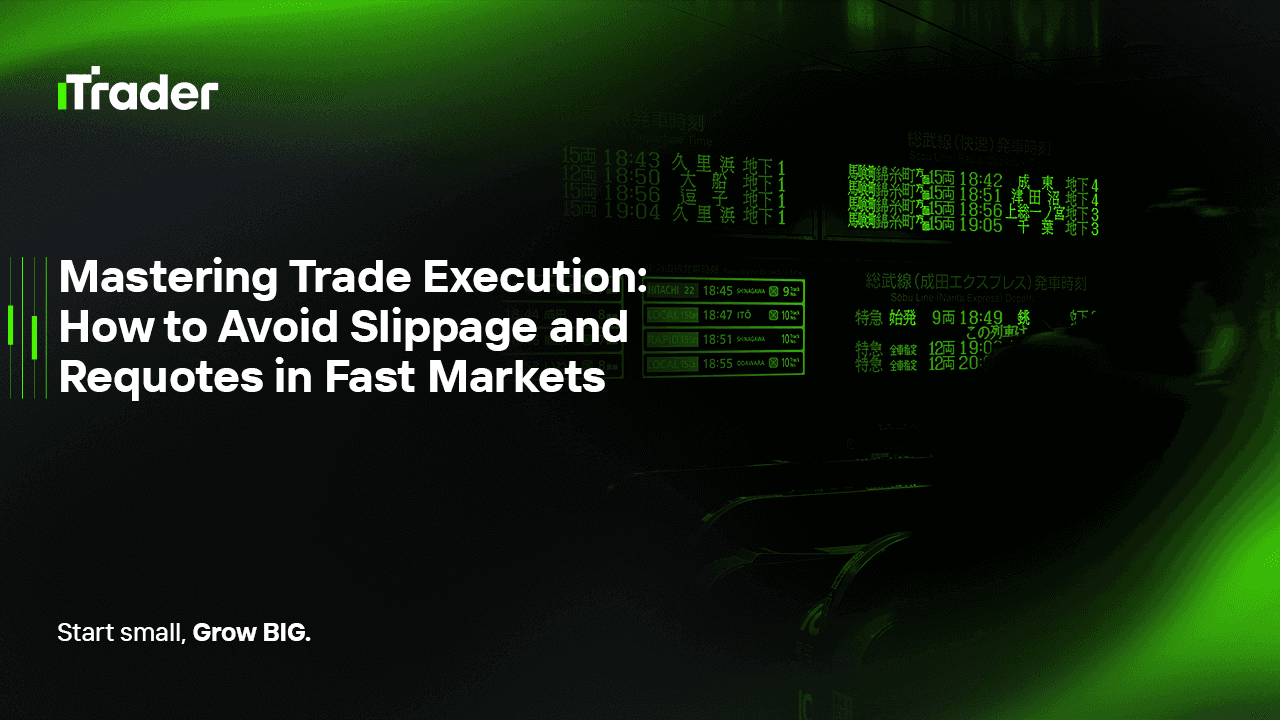2025-09-22
Every trader knows the feeling: you spot the setup, hit the buy button, and then… your entry isn’t where you expected. The market moved a little, your broker slipped the order, or worse—they sent you a requote. Suddenly your risk looks bigger, your reward-to-risk ratio is skewed, and frustration creeps in.
For retail traders this might be an annoyance, but for prop traders it’s a different story. Slippage and requotes can be the difference between passing or failing an evaluation. When a firm sets strict drawdown rules, even small execution errors matter.

In this blog, we’ll break down what slippage and requotes really are, why they hit prop traders harder, and what you can actually do to manage them. Think of it as a trader-to-trader conversation about one of the least glamorous but most important parts of the game: getting filled at the right price.
Execution isn’t just clicking “Buy” or “Sell.” It’s the whole chain:
Along that chain, two things can happen:
If you’ve ever traded around big news events, you’ve definitely seen one—or both.
Slippage is simply the gap between your intended price and your actual fill.
Example: You buy EUR/USD at 1.1000. Instead of 1.1000, you get filled at 1.1003. That’s a 3-pip slippage against you.
A requote is when your broker says: “Sorry, we can’t fill you at that price. Here’s a new one—do you want it?”
Example: You try to buy GBP/USD at 1.2500. The broker responds: “New available price: 1.2505.” You must accept or cancel.
Requotes are most common with dealing desk brokers, especially when markets are moving fast. They’re frustrating because they interrupt your flow—you either chase the market or miss the trade.
For a retail trader, slippage and requotes just eat into profit margins. For a prop trader, they can break the rules of the game.
That’s why execution quality is part of being a professional. Strategy alone isn’t enough.
Here’s the truth: you’ll never fully escape slippage. It’s part of trading. What matters is how you prepare for it and respond when it happens.
The traders who survive in prop aren’t the ones with zero slippage—they’re the ones who accept it and keep their discipline intact.
Execution isn’t just a technical detail—it’s part of risk management.
Picture this: it’s Nonfarm Payroll Friday. Your system calls for a breakout buy at 1.0800 in EUR/USD.
For many traders, this kind of slippage is enough to break a prop evaluation. The smart play? Sit out unless your system is specifically designed for that chaos.
Good traders measure everything—including execution.
Execution data is part of your trading edge. Ignore it, and you’re trading blind.
Slippage and requotes aren’t glamorous topics. They don’t show up in flashy strategy backtests. But for prop traders, they’re deal-makers or deal-breakers.
You can’t eliminate them, but you can manage them. The keys are:
Prop firms don’t expect perfection—they expect professionalism. Managing execution is part of proving you’re ready to handle real capital.
© 2025 iTrader Global Limited|会社登録番号:15962
iTrader Global Limitedは、コモロ連合のアンジュアン自治島ムツァムドゥのHamchakoに所在し、コモロ証券委員会によって認可・規制を受けています。ライセンス番号は L15962/ITGL です。
iTrader Global Limitedは「iTrader」の商号で運営しており、外国為替取引業務を行う許可を受けています。会社のロゴ、商標、ウェブサイトはすべて iTrader Global Limited の専有財産です。
iTrader Global Limitedの他の子会社には、iTrader Global Pty Ltd(オーストラリア会社登録番号(ACN):686 857 198)が含まれます。 この会社は、Opheleo Holdings Pty Ltd(オーストラリア金融サービスライセンス(AFSL)番号:000224485)の認可を受けた代表者(AFS代表番号:001315037)です。登録住所は Level 1, 256 Rundle St, Adelaide, SA 5000 です。
免責事項: この法人は、本ウェブサイト上で取引される金融商品の発行者ではなく、それらに対して責任を負いません。
リスク警告: 差金決済取引(CFD)は、レバレッジにより資本の急速な損失リスクが高く、すべての利用者に適しているとは限りません。
ファンド、CFD、その他の高レバレッジ商品を取引するには、専門的な知識が必要です。
調査によると、84.01%のレバレッジ取引者が損失を被っています。取引を開始する前に、リスクを十分に理解し、資金を失う可能性があることを認識してください。
iTraderは、レバレッジ取引によるリスク、損失、またはその他の損害について、個人または法人に対して一切の責任を負わないことを明言します。
利用制限: iTraderは、法律、規制、または政策によりこのような活動が禁止されている国の居住者を対象として、本ウェブサイトやサービスを提供していません。